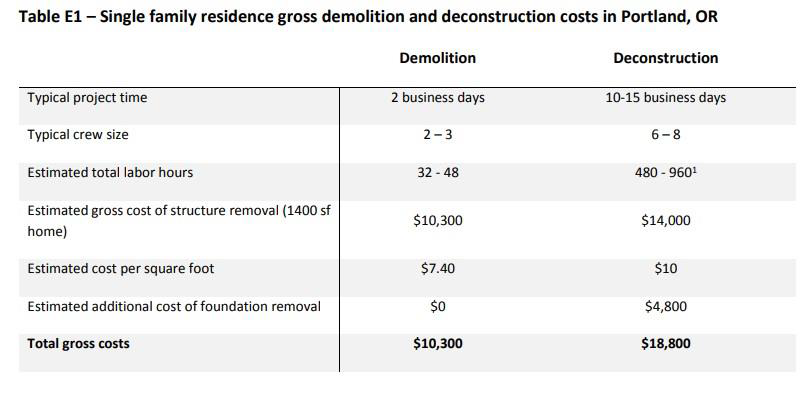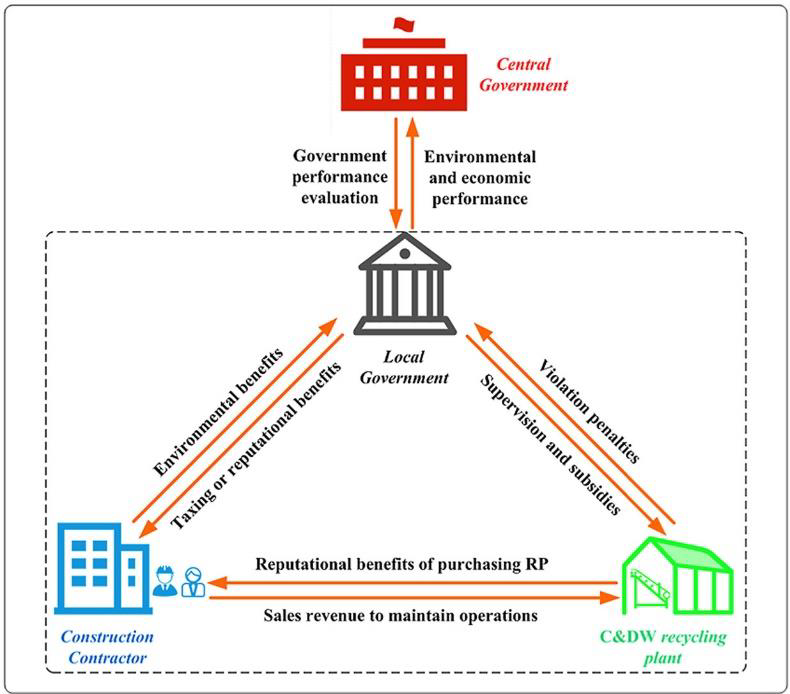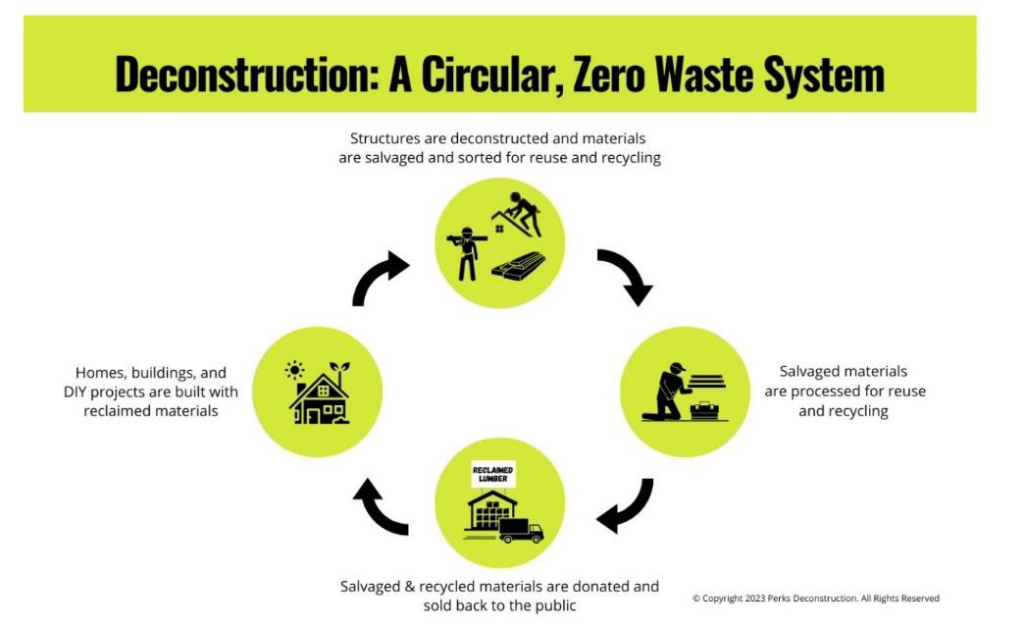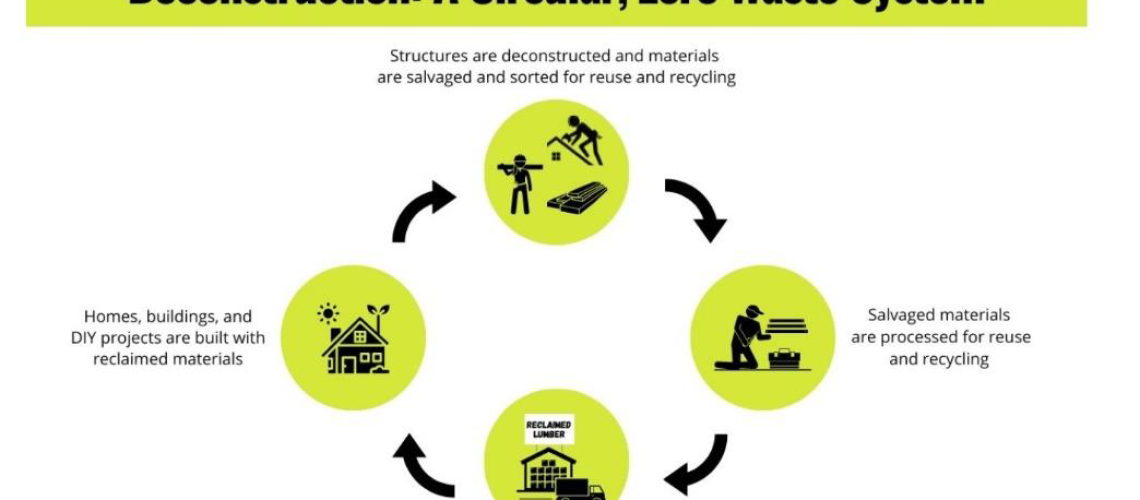Guest post by Carla Galvanoni, Interior Designer and LEED Green Associate
On a recent construction site visit to Chicago, I nearly tripped and took a header into a pile of doors. Not the “header” spanning a doorway, the other kind that includes a doctor and stitches. I asked my general contractor what he was going to do with the 12 existing doors being replaced with new interior doors. He pointed out the window to the big orange dumpster indicating demolition and ultimate landfill. I thought to myself, these doors could be re-used, so why aren’t interior and construction professionals more proactive with deconstruction versus demolition?
As a practicing interior designer who is very familiar with the construction process, I should put blinders on when I walk through residential job sites during “demo” because I am like a kid in a puppy store. I want to sift through old trim, woodwork, and floorboards and imagine what I could take to play with at home. At one point early in my career, I told my father who is a general contractor that I wanted to start a salvage store, make it fancy, and sell old beams, floorboards, and windows. He laughed and said I would drive myself crazy and make no money. Fast forward 20 years, the birth of HGTV and a million shelter magazines, it would seem to be a boom time for the deconstruction and salvage industry. Furthermore, there is the sustainability issue with construction and demolition materials (C&D) comprising large amounts of local landfills, upwards of 20% in some municipalities (Paruszkiewicz et al., 2016)
These concerns have led me to ask the following research question: where is the market for sustainable deconstructed construction materials? Taking a triple bottom line approach, there is an environmental need, a market gap, and job opportunities. What is going on?
There is a big difference between demolishing a structure such as a house and deconstructing it. Demolition involves the destruction and hauling away of a structure to landfills and incinerators. The structure is literally at the end of its’ life. Nothing is re-used or recycled. Deconstruction takes a life cycle approach and “dismantles” a structure; cataloging, hauling, storing, and re-using most components for another structure. It is nearly 80% more expensive to deconstruct a typical single-family residence than demolishing the structure. The labor costs for deconstruction can be 75% higher than demolition (Paruszkiewicz et al., 2016). On the flipside, the hauling and waste fees for demolition are the bulk of the cost of a demo job versus a deconstruction. Overall, it comes down to a mix of factors including costs, time, and sustainable values. I like tables and charts, so I found this one that provides a snapshot of the demolition costs versus deconstruction costs in Portland, Oregon.

The topic of deconstruction concerns various stakeholders including the general contractors, the recycling or deconstruction subcontractors and the government, both local and federal, who develop standards that are in place for recycling and re-use of materials. Contractors are willing to pay a premium for environmentally resourced materials such as wood and metals for building when there are reputation benefits involved with purchasing (Su et al., 2020). The challenge can be finding a local salvage shop or deconstruction contractor who can get the job done. The business of disassembling can be messy, dangerous, expensive, and often hard to find the professional within the profession.
The graphic below shows a simple stakeholder strategy.

(Su et al., 2020)
As inhabitants of this earth, humans have been generating waste in all forms since early times. From ancient Rome and the aqueduct “plumbing” that flushed away human waste, to the 19th-20th century cities grappling with trash on the streets, waste management has been a community issue. Reusing and re-purposing materials has also been a trendy past-time. Marble sculptures and facades on churches throughout Italy show where pieces were removed and “traded up” rather than destroyed and re-built throughout the ages. The industrial revolution created a new stream of mechanical waste comprised of metals and chemicals haphazardly discarded and mixed in with all trash disposed often in water, grasslands and buried within city limits. In fact, up until 1993, most construction and demolition (C&D) waste was mixed in with municipal waste and not sorted (Kumar, 2011). The proliferation of new urban skyscrapers and buildings throughout the 20th century created a boon toward economic development for the waste industry and did very little by way of healthy disposal and sustainability. (Bertino et al., 2021). Even today, communities and neighbors who live near a demolition site could be exposed to the release of hazardous materials during demolition. Salvaging and deconstructing structures can be less hazardous to the surrounding environment and community.
Through an online analysis using search terms, deconstruction, recycled building materials, and salvaged building materials, I found a local Denver deconstruction firm, woman owned, and full of great reviews. They have an entire lumber section inventory of 2×4’s, 2×6’s and LVL beams. You could probably source enough lumber for an entire ranch size home! The eye-catching website, interesting facts and up to date policy information about the city of Denver about recycle-reuse during demolition are impressive.

Shopping at salvage architectural artifact locales is a great way to incorporate old character and stye while practicing sustainability and resourcefulness. One of my favorite salvage shops, Salvage One, is located on the west side of Chicago. Salvage One is full of deconstructed millwork and old artifacts from buildings as well as some furniture. I was on their website, just looking, and saw that they are now renting out the space for weddings. I am sure this helps offset the rent and bring in extra revenue for this meager margin business, but it may also bring some awareness to salvaged home goods. Can you imagine the cool stuff you could buy for the newly married couple? Perhaps a new/old oak beam or stained-glass window circa 1890 for their new digs? I know where they can find some interior doors!
Living in Colorado, we are fortunate to be a part of the small group of cities requiring a recycle and re-use plan for demolition on jobs. Please take a moment and click on the link below to familiarize yourself before your next construction project! Our environment, economy and labor force can benefit from deconstruction.
Denver now requiring recycling and reuse plans for demolition jobs — Perks Deconstruction: A Cleaner, Greener Way to Demo
(Denver Now Requiring Recycling and Reuse Plans for Demolition Jobs, n.d.)
References
Bertino, G., Kisser, J., Zeilinger, J., Langergraber, G., Fischer, T., & Österreicher, D. (2021). Fundamentals of building deconstruction as a circular economy strategy for the reuse of construction materials. Applied Sciences, 11(3), Article 3. https://doi.org/10.3390/app11030939
Denver now requiring recycling and reuse plans for demolition jobs. (n.d.). Perks Deconstruction: A Cleaner, Greener Way to Demo. Retrieved January 7, 2024, from https://www.perksdeconstruction.com/blog/denver-now-requiring-recycling-and-reuse-plans-for-construction-and-demolition-jobs
Kumar, S. (2011). Integrated Waste Management: Volume I. BoD – Books on Demand.
Paruszkiewicz, Mike; Liu, Jenny H.; Hanes, Rebecca; Hoffman, Eric; Hulseman, Peter; and Willingham, Emma, “The economics of residential building deconstruction in Portland, OR” (2016). Northwest Economic Research Center Publications and Reports. 1. https://pdxscholar.library.pdx.edu/nerc_pub/
Su, Y., Si, H., Chen, J., & Wu, G. (2020). Promoting the sustainable development of the recycling market of construction and demolition waste: A stakeholder game perspective. Journal of Cleaner Production, 277, 122281. https://doi.org/10.1016/j.jclepro.2020.122281
 Carla Galvanoni, Interior Designer, LEED Green Associate
Carla Galvanoni, Interior Designer, LEED Green Associate
I am a practicing interior designer and business owner with over 12 years of professional practice in residential and small commercial interiors. I am currently pursuing a master’s degree in design and merchandising with a focus on sustainable design, specifically material sample and sourcing methodologies at Colorado State University. My professional goals include teaching and mentoring interior design students as well as continuing to implement LEED practices into design projects. In June 2023, I earned my LEED Green Associate accreditation and am preparing for the WELL exam in 2024.
Extracurricular activities include spending time with my three grown kids, who are much more socially conscious and aware of green washing marketing than me. My husband and I love to travel and visit our son at Syracuse University and daughter at CU Boulder. We try to visit our alma mater, University of Illinois Urbana-Champaign, and have no qualms about bribing our youngest to pick a Big Ten school for college.
Growing up in a construction and architecture household, I love everything about the field and the constant challenges and changes in design. The area of sustainable interiors resonates with my business as clients are finally asking for “healthy” material options. I enjoy educating owners (and hopefully interior design students someday) about healthier products and sustainable options for the built environment.






